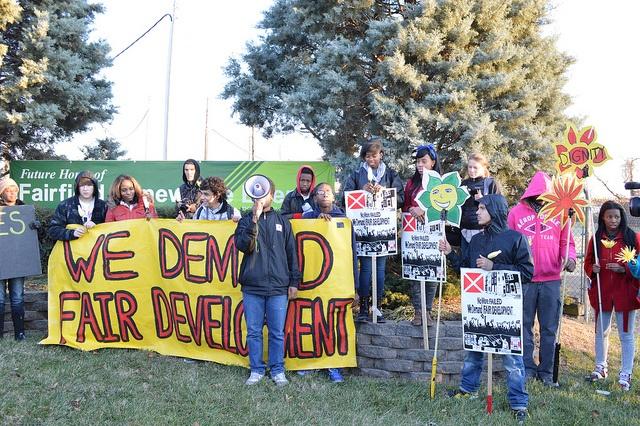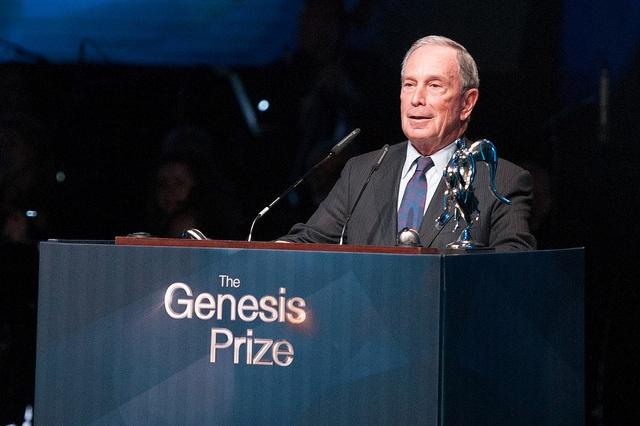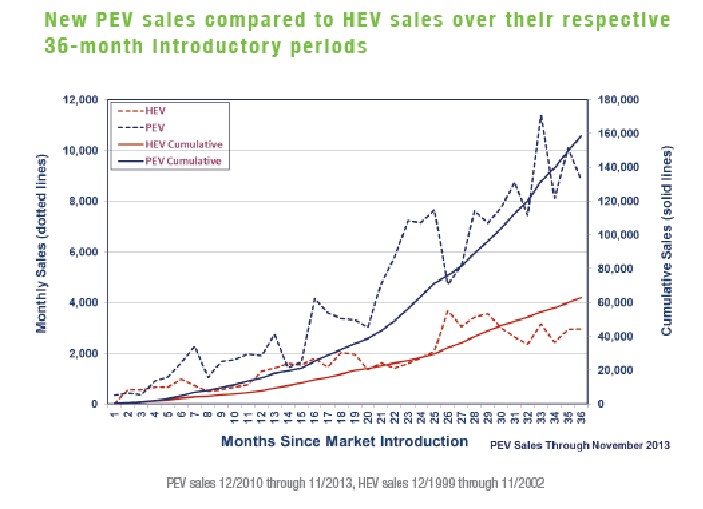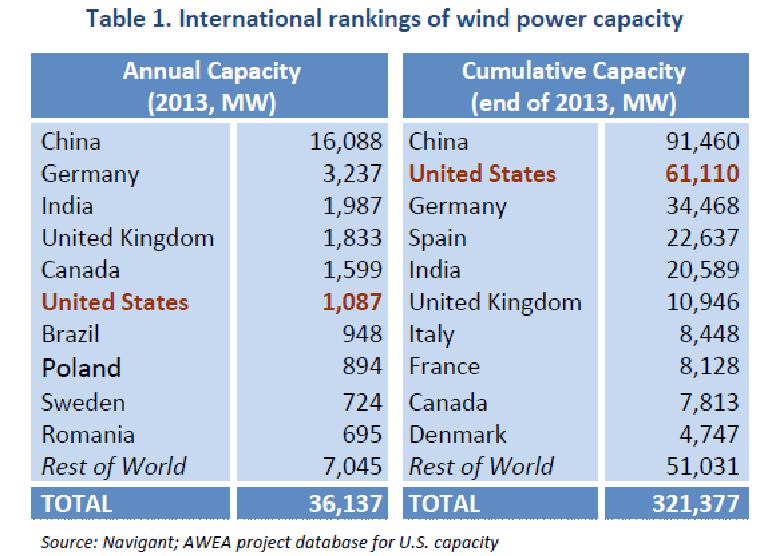Poll Clears Up Misconceptions: People of Color Concerned About Climate Change


Earlier this month, hundreds of community activists gathered near the Chevron oil refinery in Richmond, Calif., to mark the two-year anniversary of the facility’s explosion that sent more than 15,000 individuals from the surrounding community to the hospital. These campaigners – which included residents of this racially diverse, low-income city to the east of San Francisco – were passionate about the issue of climate change, announcing they had also come together to brainstorm local solutions to the climate crisis.
Despite this rally in Richmond and the long-standing environmental justice movement, the misconception that people of color don’t care about environmental issues remains. But a new poll commissioned by the nonprofit Green For All reveals what we should have known all along: Communities of color are not only concerned about the environment, but also view climate change as an imminent threat.
According to the survey, 68 percent of African American, Latino and Asian likely voters think climate change is an issue that Americans need to be worried about right now – not a problem we can put off in the future. And a whopping 75 percent reported that they are following new information on climate change more closely than in the past.
Whether the climate crisis was labeled as “climate change” or “global warming,” a majority of survey respondents felt we need to devote more resources and attention to address the issue: About 62 percent said not enough resources have been allocated to climate change, while 55 percent stated they felt not enough has been designated for global warming.
And politicians should take note: Due to this heightened awareness of climate change and other environmental concerns, 70 percent of voters surveyed said that they were more likely to support candidates willing to “expand resources” (read: spend money) to combat climate change – over politicians that say addressing climate change will kill jobs and hurt the economy.
The survey, conducted by polling firm Brilliant Corners this summer, questioned 400 African American and 400 Latino likely voters from eight battleground states, like Florida and Ohio, as well as 100 Asian likely voters from Los Angeles and the San Francisco Bay Area.
It should come as no surprise that people of color think we need to take action on climate change. These communities are concerned with issues that affect their daily quality of life: the cost of food and gas, as well as access to transportation, health care, and clean air and water. Changing climatic conditions touch all of these areas – from shrinking crop yields and damaging infrastructure to exacerbating droughts and air pollution. Furthermore, communities of color are often more vulnerable to the effects of climate change, with Hurricane Katrina being a prime example.
“There is a lot of rumor and speculation surrounding what people of color think about climate change and the environment,” Green For All’s Executive Director Nikki Silvestri said in a statement. “Yet, too often the communities that are hit first and worst by the impacts of climate change are not part of the discussion. But, the answer is clear. People of color care deeply about the environment and the impacts of climate change. We understand the urgency of these threats because we experience the effects every single day.”
In an interview with Grist, Dorceta Taylor, professor at the University of Michigan’s School of Natural Resources and Environment, spoke about the erroneous belief that people of color aren’t concerned with environmental issues, focusing on the African American community.
The perception that people of color don’t care about the environment has existed for a long time, and has been debunked for just as long. We can go back to [historian] W.E.B. DuBois, whose 1898 study on Philadelphia looked at the housing and health conditions of African Americans. People have described it as a sociological study, but if you read it, it is an environmental study, if ever there was one. He looked at the environmental conditions of these communities, but he linked them with social inequality and justice issues.Before that, look at Harriet Tubman. We tend to think of her as someone only successful on the Underground Railroad, but to be that successful she was steeped in environmental and ecological knowledge. She knew the Chesapeake Bay so well that the U.S. military used her at the head of their ships to identify landmines the Confederates had laid in the water and identified them based off what she understood about disturbances in the water.
Slaves depended on ecological knowledge and were extremely effective at it — they used it to survive slavery. So the notion that we don’t care or know about the environment is just a fallacy.
But beyond climate change’s connection to health and security, there is also an issue of ethics: Over 30 percent of the minority voters polled said that the most significant reason for supporting new carbon emissions standards was a moral duty to leave their children a habitable planet.
Whether due to morality or more pragmatic quality-of-life concerns, it is clear that communities of color care about climate change. But, with other polls showing that more than half of Americans worry about climate change very little or not at all, will their support convince politicians to stop dragging their feet on climate solutions?
Image credit: Flickr/United Workers
Passionate about both writing and sustainability, Alexis Petru is freelance journalist based in the San Francisco Bay Area whose work has appeared on Earth911, Huffington Post and Patch.com. Prior to working as a writer, she coordinated environmental programs for Bay Area cities and counties. Connect with Alexis on Twitter at @alexispetru
Consumer Brands Face Tax Haven Pressure While B2Bs Get Free Pass


Last month, Andrew Ross Sorkin reported in the New York Times that Walgreens was "considering moving the company’s headquarters to Switzerland as part of a merger with Alliance Boots, a European drugstore chain. Why? To lower Walgreens' tax bill even further.” The news struck a nerve with many of the pharmacy chain's regular customers, including Triple Pundit contributor Raz Godelnik.
On August 6, CEO Greg Wasson announced that Walgreens would move forward with its merger with Alliance Boots. But, in the face of mounting consumer pressure, Wasson hastened to add that the company would keep its incorporation in the U.S., foregoing an estimated $4 billion in tax savings over five years.
Corporate responsibility advocates were quick to label the story a win from a stakeholder engagement standpoint, and it surely shows what can happen when consumers take action. But it also begs the question: Why Walgreens?
As 3p's Raz Godelnik pointed out, the pharmacy chain is hardly alone: According to a June report published by Citizens for Tax Justice and the U.S. PIRG, at least 362 companies, making up 72 percent of the Fortune 500, operated subsidiaries in tax haven jurisdictions as of 2013. Among these companies you can find top labels like Apple, Nike and American Express, along with huge money-makers that exist mostly outside of the public eye, such as Pfizer, Air Products and Chemicals and Amgen. So, what was it about the Walgreens case that created such a stir?
One one hand, Walgreens markets itself as the 'friendly neighborhood pharmacy' and has spent millions of dollars to establish itself as a household name. The pharmacy giant has also become increasingly vocal about its sustainability journey in recent years. So, it's no surprise that customers were quick to point fingers at the company for departing from the sustainable brand message it worked so hard to develop.
But before we break out the tar and feathers, it's worth asking about other players in the game that perhaps aren't attracting as much attention. Scores of industry-facing companies operate in relative obscurity as far as the public is concerned. Also known as business-to-business or B2B companies, these firms are often free to make whatever choices they see fit -- sustainable or not -- with little fear of consequence. They don't need to shell out big bucks for marketing; their customers (other companies and even governments in some cases) already know about them -- and have likely been spending millions on their products for decades.
The other side of the coin
Because industry-facing companies have little to no brand recognition on their own, they often sidestep the court of public opinion, while it often seems like well-known consumer-facing companies can never do enough. Even when a large, well-recognized company -- Walgreens, McDonald's, Coca-Cola and the like -- announce a sustainability accomplishment, critics are quick to point out other aspects of the firm's business they deem unsustainable. But, by this argument, isn't the same the case for businesses whose main source of revenue center around 'unsustainable' activities, like oil and gas companies or ballistics manufacturers?
As 3p's Andrew Burger recently pointed out, many of these intrinsically 'unsustainable' industries, such as the oil and gas industry, often have an even broader set of tools at their disposal to avoid paying U.S. taxes. According to a study from Taxpayers for Common Sense, large, U.S.-based oil and gas companies, “paid far less in federal income taxes than the statutory rate of 35 percent” from 2009 through 2013. “Thanks to a variety of special tax provisions, these companies were also able to defer payment of a significant portion of the federal taxes they accrued during this period.”
Twenty of the largest oil and gas companies reported a total $133.3 billion in U.S. pre-tax income over the five-year study period. They were billed $32.1 billion, an effective 24 percent federal tax rate. But special provisions in the U.S. tax code allowed them to defer payment of more than half this bill -- meaning these companies actually paid only $15.6 billion, or 11.7 percent. To make matters worse, the total amount of net deferred tax liability for some of these companies "has grown to represent a significant share of their net worth," Burger wrote earlier this month -- as much as 42 percent for some firms.
For most individuals, whose tax rates can reach nearly 40 percent depending on income, stats like this inevitably send blood into a boil. So, how is it that these and other cringe-worthy figures continue to fly under the radar while the likes of Walgreens are named public poster-children for tax avoidance?
From good intentions to real change
This is not to say that folks were wrong in criticizing Walgreens, and I personally feel the chain's move to stay in the states was the right decision, but the case presents an opportunity to put things in perspective. Rather than singling out specific companies for their tax choices, why not seek to inspire a broader change in the tax code?
For the mainstream audience, taxation isn't exactly a sexy topic, but, when brought to a personal level, it's clearly something the public cares about. Sure, it may be unreasonable to expect the average person to know the net earnings and effective tax rates for every company out there. But we can likely all agree that when a Fortune 500 company is paying less than 15 percent in taxes, while middle-class families pay upwards of 25 percent, something is not quite right.
That said, while tax avoidance measures are ethically questionable, they remain unquestionably legal, which, in my humble opinion, is the true issue at hand.
The debate on this topic will surely rage on. But the next time we read a high-profile tax avoidance story that sends our pantaloons into a bunch, it may benefit us to remember all those similar stories that are rarely told. When it comes down to it, pushing to close corporate tax loopholes, whether in the voting booth or in a friendly Sunday dinner debate, is the best way to create permanent change. After all, as responsibility advocates, plugged-in voters and conscious consumers, isn't permanent change our main objective in the end?
Image credit: Flickr/jeepersmedia
Based in Philadelphia, Mary Mazzoni is a senior editor at TriplePundit. She is also a freelance journalist who frequently writes about sustainability, corporate social responsibility and clean tech. Her work has appeared in the Philadelphia Daily News, the Huffington Post, Sustainable Brands, Earth911 and the Daily Meal. You can follow her on Twitter @mary_mazzoni.
Connecting the Dots: Honey Export Loss Leads Mexico to Dump Monsanto’s GM Soy


With another school year about to start, it’s a good time to reflect on the basic sciences: physics, chemistry and biology, and how important our understanding of them can be in dealing with what have become substantial threats to our existence.
A relatively small change in the mixture of gases that constitute our upper atmosphere has altered an obscure physical property known as its radiative transmissivity. The additional gases are the byproduct of the fossil fuel energy sources that have made our modern way of life possible. The result is that heat emanating from our planet that formerly passed into space is now being reflected back to Earth, resulting in a warmer planet. While this might sound benign, it’s is causing massive melting of polar ice, releasing tremendous amounts of moisture into the ocean and atmosphere, and dramatically altering our climate. That’s physics.
Synthetic fertilizers containing nitrogen, phosphorus and potassium, primarily produced from natural gas and ammonia, have powerfully enhanced our ability to grow food to feed our ever-increasing population. However, as soils have changed their composition in response this modified diet, their ability to hold moisture has lessened. This means that heavy rains produce runoff, allowing large amounts of these chemicals to be washed into streams, rivers and lakes, altering their composition and, in some cases, making the water unfit to drink. That’s chemistry.
Micro-organisms that survive by invading animal hosts in the wild sometimes evolve to live on human hosts as well. These new diseases can appear suddenly, as in the most recent Ebola outbreak, and given the speed and intensity which we now travel and interact, can also spread rapidly before any treatment or cure can be developed. Massive epidemics that can threaten the existence of entire populations are now increasingly possible. That’s biology.
These existential threats underscore the need for increased emphasis on the STEM (science, technology, engineering and math) disciplines that have been in decline here in the U.S. in recent decades.
Each of these threats acts differently. The physical threat of climate change acts across the entire globe -- disrupting agricultural patterns with a mixture of flooding and drought as atmospheric moisture, driven by increasing masses of warm air and ocean water, is redistributed. While the entire planet is at risk, effects will be felt differently in different areas. The threat will continue to grow over the years and decades to come, building pressure on food supplies and on social and political stability with consequences that could potentially be catastrophic.
The chemical threat of pollution is also quite serious, considering how essential water is to the existence of all living things. Typically this is more of a localized effect, though the use of these chemical fertilizers and other dangerous chemicals has become widespread across the globe.
The biological threat, however, could be the most frightening, because of the rapidity and the specificity with which it could strike. A disease can lie hidden in its host for some time before becoming symptomatic. In today’s world with millions of people traveling internationally every day, an epidemic could become widespread before being discovered. That could be disastrous.
The biological world is constantly changing and evolving in ways that are difficult to predict. That is why there is such concern over efforts to tamper with the basic building blocks of life in the laboratory and then massively release them into the environment without the kind of rigorous long-term testing that agencies like the American Medical Association have proposed. As the above examples have shown, our history of technological innovation, which has been largely successful in making our lives safer and more fulfilling, has also been a history of unintended consequences -- many of which are only catching up with us now.
Government policy can be a powerful tool in controlling the spread of some of these risks. The European Union, expressing concerns over the possible risks associated with genetically modified organisms (GMOs) has established a legal framework to restrict the importation and cultivation of genetically modified food products. Their position stands in stark contrast with the U.S., which, perhaps due to the number of high-ranking government officials who are former executives in the biotech industry, is a strong supporter of the technology.
This has caused a stumbling-block in the attempts to forge a trade deal between the two, as the U.S. has asked for relaxed restrictions on GMOs as a precondition for the agreement while the EU has refused.
Now, a court decision in Mexico underscores the way that deterrents can spread across borders, almost as easily as rogue organisms: The judge ruled that the Yucatán region’s honey trade, which is crucial to the local economy, could not co-exist with the cultivation of Monsanto’s genetically modified soybeans. That’s because the honey, which is almost exclusively sold in Europe, containing the GM soy pollen, is considered contaminated, and therefore can no longer be sold. The judge has therefore revoked Monsanto’s GM soy permit.
Proponents claim that GM crops can help increase production to meet the demands of a growing population. Studies have shown that yield increases from GMO’s have been modest at best, and that hunger is more a result of unequal distribution than of inadequate supply. The U.N. food agency’s chief of research, Andrea Roberto Sonnino, has said that total food production at present is enough to feed the entire global population. The vast majority of improvements in productivity to date have come from traditional breeding techniques rather than biotechnology.
Image credit: Anna Verdina (Karnova): Flickr Creative Commons
RP Siegel, PE, is an author, inventor and consultant. He has written for numerous publications ranging from Huffington Post to Mechanical Engineering. He and Roger Saillant co-wrote the successful eco-thriller Vapor Trails. RP, who is a regular contributor to Triple Pundit and Justmeans, sees it as his mission to help articulate and clarify the problems and challenges confronting our planet at this time, as well as the steadily emerging list of proposed solutions. His uniquely combined engineering and humanities background help to bring both global perspective and analytical detail to bear on the questions at hand.
Follow RP Siegel on Twitter.
Israeli Scientists Protect Coral by Taking Rainforests Underwater


Efforts have been underway for some time now to find a way to save the world’s coral reefs. Coral, which is often thought of incorrectly as a marine plant, perform an essential symbiotic role in our oceans that often benefit other organisms. Their incredible diversity allows them to replicate in a variety of environments and makes them essential to the world’s oceans. Home to more than 800 types of coral, the world's coral reefs alone support the existence of more than 4,000 species of fish, many of which provide essential food for human populations. Other coral communities, such as those in the Red Sea, are also essential to marine life.
So, finding a way to stem the decline of coral has been a priority for marine scientists for the past several decades – at least since the late 1990s when scientists attempted unsuccessfully to replant coral in the Great Barrier Reef. According to the World Resources Institute’s 2011 report, Reefs at Risk Revisited, 75 percent of the world’s coral reefs face extinction from climate change, coastal development, pollution and overfishing.
And they are more than a form of marine animal. Often likened to the proverbial canaries in the coal mine, "coral reefs are harbingers of change,” the WRI states. The increasing extinction of coral is a clear indicator of the future of the world’s oceans.
The good news is that after years of research, scientists in Israel may have found a way to repopulate coral reefs. Dr. Baruch Rinkevich, senior scientist at Israel’s Institute of Oceanographic and Limnological Research, and Dr. Shai Shafir, chair of the department of Natural Science and Environmental Education at Oranim Academic College, have developed a means by which to regrow coral and replant it in its natural habitat.
"We grow corals on mid- water nurseries in the Red Sea," Shafir explained in a recent interview. At the present time the coral is being grown individually in the nurseries and then replanted "one by one" in the communities in the Red Sea.
Shafir refers to coral as “’the rain forest of the sea.’” Like trees, they root themselves in the earth’s floor, becoming a natural habitat for other species. The coral reforestation not only helps regenerate coral communities, but they also provide a vibrant marine ecology for those around them.
“Basically, what we’ve done here is copy the forestry concept,” Shafir said, “and the idea is really taking hold around the world because you can use it almost anywhere.” In fact, the idea has shown so much success that the Jewish National Fund has gotten behind the project, which has opened doors for a new angle on marine reforestation. Shafir said the North American Friends of the IOLR have also been instrumental in promoting and funding their work.
The concept of regrowing and replanting declining species has been around for a while in terms of kelp reforestation, but not in terms of successful replanting of coral beds. It's an idea that will benefit not just marine areas around Israel, but also worldwide.
“It’s not just about conservation, but also about active restoration,” Shafir said, who noted that the team are also working on an idea that would allow groups of coral to be grown in "carpets" or squares that could then be integrated into the marine setting. The process is still in research stage, however.
Coral replantation techniques dovetail with another form of reforestation called passive restoration, which has been in the works for years and takes much longer to accomplish. Marine protective areas, which are seen throughout the world and take decades to recover, fulfill this purpose. Active restoration, however, takes just two years to start.
Its success, and of course the speed of reforestation however, will still depend heavily on aspects of human habitat: whether we can find the impetus and mechanisms to halt climate change, marine encroachment and, of course, overfishing.
Gratitude is extended to Dr. Shai Shafir and Dr. Baruch Rinkevich for additional information and photos.
Images of mid-water coral nursery, Red Sea courtesy of Dr. Shai Shafir.
Michael Bloomberg and Genesis Prize Launch $1M Social Entrepreneurship Competition


What price would you pay to help humanity? For former New York City Mayor Michael Bloomberg and the Genesis Prize Foundation, $1 million dollars aptly foots the bill. Launched last week, the Genesis Generation Challenge aims to identify and provide seed-money for innovative projects to address the world’s toughest challenges. Ten awards of US$100,000 will be given to the engineers, artists, scientists and business people that can turn their ideas into scalable solutions that demonstrate significant impact in their particular issue area.
The competition will turn passion into reality for 10 winning teams connecting them to mentors and opportunities to convene and learn from one another. Benefits exist even for those teams that do not win; they will become part of an active network of forward-thinking and connected individuals from whom they can receive feedback and grow their ideas.
Monetary incentive aside, mentorship from politician, businessman and philanthropist Michael Bloomberg is worth its weight.
“Competitions can provide the incentives and framework to help innovative ideas surface, so we created the Genesis Generation competition to empower young people who want to make the world a better place,” Bloomberg said. “The competition will spur collaboration across borders and regions, and it will encourage young people to find new and better ways to tackle our most pressing challenges."
Fully committed to the success of the competition, Bloomberg attended the international launch in New York last week during an event that hosted over 100 social entrepreneurs and allowed potential competitors an opportunity to learn more about the competition and meet the judges. The Genesis Prize Foundation also hosted an Idea Accelerator in Washington, D.C. following the New York event for potential applicants.
Judges announced to date include: Dan Shechtman, Nobel Prize Laureate (Israel); Marjorie B. Tiven, Director of Global Cities, Inc. (U.S.); Jill Smith, President of Jewish Foundation for Education of Women (U.S.); Sana Britavsky, Deputy CEO, Chief Content Officer, Genesis Philanthropy Group (Israel); Roberta Kaplan, Partner, Paul Weiss (U.S.); David Hatchwell Altaras, President of Excem Group (Spain); Noam Lautman, Chairman, Delta Galil (Israel); Lisa Eisen, National Director for the Schusterman Family Foundation (U.S.); Rachel Haot, Chief Digital Officer and Deputy Secretary of Technology for New York State (U.S.); and Rachel Cohen Gerrol, Co-founder and Curator, Nexus Youth Summit (U.S.).
“We are thrilled to launch the competition,” commented Wayne L. Firestone, president of the Genesis Prize Foundation. “We believe in young adults’ ability to bring about solutions for the world’s most pressing problems and use their unique insight to affect change across the globe.”
In an interview with us regarding the purpose behind the competition, Firestone expressed the changing demographic of socially conscious entrepreneurs. A generation ago, he mentions, creating profitable businesses that produced societal change was not the norm. According to Firestone, prior charitable behaviors are often old school, irrelevant or not impactful at all to this generation.
Overall, The Genesis Prize Foundation hopes to mobilize creative thinkers who recognize that innovation doesn’t happen by itself…it happens through collaboration and mentorship.
A complete description of the criteria for submission, rules, application, and scoring mechanism is available at www.Genesis-Generation.org.
Image credit: Flickr/mikebloomberg
Sherrell Dorsey is a social impact branding and communications strategist, social entrepreneur and advocate for environmental, social and economic equity in underserved communities. Visit Sherrell at www.sherrelldosey.com and follow her on Twitter and Instagram @sherrell_dorsey.
China, The Nature Conservancy Work to Curb Pollution


China produces the most greenhouse gases in the world. But the country, in conjunction with the Nature Conservancy, is working to curb the causes and effects of climate change.
It might seem like a strange partnership between a nonprofit and a huge nation, but it might work. TNC’s Conservation Blueprint project identified 32 regions that the organization and the Chinese government believe are most vital to the country’s environmental future. Currently the U.S.-based conservation group is analyzing how ecosystem-based adaptation strategies “can help those regions thrive.”
To do that, TNC was granted unprecedented access to all of the country’s detailed ecological data, says Charles Bedford, managing director of TNC’s Asia Pacific region. This occurred when China signed on to the United Nation’s Convention on Biological Diversity. China considers this classified data, but the information will aid in mapping a problem-solving “battle plan,” including innovative projects that could shape China’s carbon policy for many years to come, TNC says.
For example, in Sichuan Province, TNC is launching a carbon-accounting pilot project that will help China participate in international commitments to address climate change. These efforts could play a major role in China’s efforts to establish a comprehensive national-level carbon-accounting system.
Also in Sichuan, the organization has begun huge reforestation projects that are fighting climate change and restoring habitat for giant pandas. “This work includes exploring how we can use the power of carbon markets to accelerate forest conservation and deliver economic benefits to local communities,” TNC says.
The China National Biodiversity Conservation Strategy and Action Plan (2011-2030) “demonstrates the central government’s efforts to build a greener China and highlights the positive impact that the Conservancy — the only NGO that contributed directly to the plan — and its Blueprint are having on the country’s environmental future,” TNC says.
The action plan is the first in China since 1994 and sets a number of objectives, including a halt to biodiversity loss in China by 2020. The action plan “will shape China’s environmental policies for years to come,” says Zhang Shuang, director of the Conservancy’s China program and the project leader for the Blueprint. He adds that the Conservancy’s science “is playing a crucial role in taking on the most pressing threats to China’s environment.”
It’s an enormous job in an enormous country with enormous environmental and biological diversity, along with a population of more than 1.3 billion people.
China’s rapid development as an industrialized nation has been fueled largely by its reliance on coal. To its credit, the country is taking some positive steps to curb air emissions, with news reports indicating the government will ban the use of coal in Beijing and other urban areas by 2020. Last month, Wang Yi, a Chinese academic who is also a senior lawmaker, was quoted in a New York Times article as saying the government is considering a national cap on coal use as soon as 2016.
“The wretched air in China’s cities is forcing Chinese officials to change their energy policies. If they do a good job tackling local pollution, they could also have a big impact on climate change,” said a New York Times editorial over the weekend.
Will it be enough? Will the timetable for curbing coal use spur a coal consumption spree that could heavily harm the environment before restrictions kick in? Those are questions and concerns for another day. For now, it’s encouraging that China is coming to its senses.
Image credit: Chongqing from Yi Ke Shu Observation by Sam Gao via Flickr
DOE Looks Beyond Lithium with 'EV Everywhere' Grand Challenge


Aiming to advance development of efficient-vehicle technologies, the U.S. Department of Energy last week announced it will provide $55 million in funding for 31 projects “to accelerate research and development (R&D) of critical vehicle technologies that will improve fuel efficiency and reduce costs.”
Much of the funding is being devoted to projects that, in one way or another, will help realize the goals set out in President Barack Obama's EV Everywhere Grand Challenge. Announced in March 2012, the challenge aims to reduce the costs and improve the performance of plug-in electric vehicles (PEVs) to the point where they “are as affordable and convenient as today's gasoline-powered vehicles by 2022.”
DOE has invested $225 million in EV Everywhere projects to date in order to lower PEV costs, increase range and develop a PEV charging infrastructure. Among other achievements, EV Everywhere R&D projects have cut the cost of PEV batteries nearly in half, to $325/kilowatt-hour (kWh), since 2010.
The EV Everywhere Grand Challenge
As DOE highlights in The EV Everywhere Grand Challenge: Road to Success, its first program assessment report, consumer acceptance of PEVs is on the rise: Nearly 100,000 PEVs (97,000) were sold in 2013, nearly double that of 2012. More than 50 companies have joined the DOE's “Workplace Charging Challenge,” pledging to provide PEV charging at more than 150 sites.
Nineteen of the 31 projects in the latest EV Everywhere funding round aim to reduce the cost and improve the performance of key PEV components. These include development of next-generation PEV batteries that go beyond lithium by making use of higher-energy-storage materials; developing and commercializing wide bandgap (WBG) semiconductors that can improve performance and reduce the cost of vehicle power electronics; and the development of lightweight materials that can reduce energy use and increase the driving range of PEVs.
In its latest round of efficient-vehicle funding, DOE is also funding 12 projects that aim to develop and demonstrate dual-fuel, or bi-fuel, technologies that reduce petroleum consumption, speed up growth in affordable, high-efficiency engine and powertrain systems for light-duty vehicles, and accelerate the introduction of advanced lubricants that can enhance vehicle efficiency today and in the future.
Commenting on the latest round of R&D funding, DOE Secretary Ernest Moniz said:
“Investments in the next generation of vehicle technologies will both strengthen our economy and lead to a more fuel efficient, clean energy future. Improving vehicle efficiency is instrumental to establishing a 21st century transportation sector that creates jobs as well as protects future generations from harmful carbon emissions.”
Moving beyond lithium
Reducing the cost and enhancing the performance of PEV and PHEV (plug-in hybrid) battery technology is a focal point for EV Everywhere R&D -- the 2022 target being to bring costs down to $125/kWh and boost performance to 400 Wh/liter, 250 Wh/kg and 2,000 W/kg. As DOE highlights in a press release:
Sales of PEVs grew 30 percent year-over-year during 2014's first half, while the cost of battery technology has dropped 60 percent since 2009.
Joining the DOE in the latest round of efficient-vehicle R&D funding, the Department of the Army is providing $3.7 million in co-funding for projects focused on moving beyond lithium-ion battery technologies, as well as reducing powertrain friction and wear.
“Partnering with the Energy Department, we are accelerating the development and deployment of cutting-edge technologies that will strengthen our military, economy, and energy security,” Dr. Paul Rogers, director of the U.S. Army Tank Automotive Research, Development and Engineering Center, was quoted as saying.
Moving beyond lithium-ion
Looking to go beyond current lithium-ion battery technology, results from the Battery Performance and Cost (BatPaC) model developed at Argonne National Laboratory indicate that the EV Everywhere PEV cost target can be reached using a combination of lithium- and manganese-rich high-energy cathode (LMRNMC) and silicon alloy anodes. The model also indicates the target can be reached using PEV batteries with silicon alloy anodes and lithium metal batteries.
In the latest funding round, DOE is providing a total of $7.77 million for six R&D projects that aim to go beyond lithium-ion technologies. Recipients include the boards of trustees of the Leland Stanford Junior University, Liox Power of Pasadena, Michigan State University, the State University of New York at Binghamton, the University of Maryland and the University of Pittsburgh.
Boosting the performance and reducing the cost of electric drive systems is another focal point of the EV Everywhere Grand Challenge. The 2022 targets are to bring costs down to $8/kW and to realize performance goals of 1.4kW/kg specific power, 4.0 kW/L power density, and 94 percent system efficiency, which translates to a cost of $440 for a 55-kW electric drive system, according to the DOE.
*Images credit: U.S. Department of Energy (DOE)
U.S. Second in Installed Wind Power But Growth Uncertain


The U.S. continues to be a world leader when it comes to installed wind power capacity, ranking second worldwide, despite modest growth in 2013. U.S. installed wind power capacity met nearly 4.5 percent of total national electricity demand last year, and U.S. renewable energy electricity generation is poised to double again by 2020, according to two reports released August 18 by the U.S. Department of Energy (DOE).
Persistence of key policy incentives is pivotal to ongoing growth in wind and renewable energy capacity, however, the DOE noted. With lobbying from Koch Industries' Americans for Prosperity (AFP), Republican Gov. Sam Brownback of Kansas recently came out in favor of phasing out the federal wind energy production tax credit (PTC), which expired Dec. 31. Pushing for renewal of the wind energy PTC, the American Wind Energy Association (AWEA) recently ran TV and YouTube ads thanking members of Congress in Colorado and Iowa, for their strong, bi-partisan support of wind energy and the PTC renewal.
“As a readily expandable, domestic source of clean, renewable energy, wind power is paving the way to a low-carbon future that protects our air and water while providing affordable, renewable electricity to American families and businesses,” DOE Secretary Ernest Moniz was quoted in a news release. “However, the continued success of the U.S. wind industry highlights the importance of policies like the Production Tax Credit that provide a solid framework for America to lead the world in clean energy innovation while also keeping wind manufacturing and jobs in the U.S.”
2013 U.S. Wind Technologies Market Report
Nearly 61 gigawatts (GW) of wind power capacity had been installed in the U.S. as of year-end 2013, according to the DOE-Lawrence Berkeley National Laboratory's 2013 Wind Technologies Market Report.
Utility-scale wind turbines are now up and running in 39 U.S. states and territories. That's generated a lot in the way of green economic and job growth, as well as clean, renewable electrical power that helps avoid the worst effects of a changing climate.
Wind energy prices are at an all-time low, the report authors highlight, particularly in the U.S. interior, where utilities are now able to reduce the costs of new power generation capacity by installing wind turbines and connecting them to the grid.
Furthermore, growth of wind power “has had a ripple effect on the American economy, spurring more than $500 million in exports and supporting jobs related to development, siting, manufacturing, transportation and other industries,” the reports authors said.
Distributed wind power generation
Accounting for more than 80 percent of all wind turbine installations in the U.S. in 2013, distributed wind power applications reached a cumulative 842 megawatts (MW). This is enough to meet the electricity needs of 120,000 average American homes, according to a second report released August 18, the 2013 Distributed Wind Market Report, which was produced by the DOE and its Pacific Northwest National Laboratory.
As the DOE explained, “Distributed wind energy installations supply power directly to the local grid near homes, farms, businesses and communities. Turbines can range in size from a few hundred watts to mult-megawatts, and can help power remote, off-grid homes and farms as well as local schools and manufacturing facilities.”
According to the report, some 72,000 wind turbines are up and running across the 50 U.S. states, Puerto Rico and the U.S. Virgin Islands. More than 10 MW of distributed wind power capacity is now up and running in 14 states – Iowa, Nevada and California among them.
U.S. wind power growth prospects
Prospects for more robust growth this year and in 2015 are better, given that wind energy projects that broke ground prior to the PTC's expiration in December 2013 will be coming online. Just how robust remains uncertain, however, the DOE noted.
“The PTC has expired, and its renewal remains in question. Continued low natural gas prices, modest electricity demand growth, and limited near-term demand from state renewables portfolio standards (RPS) have also put a damper on industry growth expectations.
“These trends, in combination with increasingly global supply chains, continue to impact domestic manufacturing of wind equipment. What they mean for wind power additions through the end of the decade and beyond will be dictated in part by future natural gas prices, fossil plant retirements, and policy decisions. At the same time, recent declines in wind energy costs and prices and the potential for continued technological advancements have boosted future growth prospects.”
Though the U.S. ranks second among nations in installed wind power, it doesn't rate nearly as highly in terms of wind power penetration, the DOE points out.
“A number of countries are beginning to achieve high levels of wind penetration: end-of-2013 installed wind power is estimated to supply the equivalent of 34 percent of Denmark’s electricity demand and approximately 20 percent of Spain, Portugal and Ireland’s demand.” That leaves a lot of room for improvement, and more proactive government policies that support faster growth of U.S. wind power deployment.
*Images credit: U.S. Dept. of Energy
Salmonella Trial Illustrates Glaring Holes in Food Safety Control


As the first federal criminal trial related to food-borne illnesses enters its third week, witnesses reveal a lack of regulatory oversight and unpalatable details of production at the Peanut Corporation of America (PCA), the company responsible for causing a 2008-2009 outbreak of Salmonella that killed nine and sickened over 700.
Samuel Lightsey, former plant manager at PCA, returned to the stand on Monday for his seventh day of testimony on the case, which alleges that the company knowingly shipped contaminated products to its customers and lied to federal authorities. According to Lightsey, the company prioritized sales over food safety concerns and had a system for deceiving its customers that included using fake lab results for untested or tainted products.
In his testimony on August 8, Lightsey explained that PCA regularly shipped its peanut butter to Kellogg’s, which had requested Salmonella testing, with false test results. Lightsey said that Mike Parnell, food broker and brother of CEO Stewart Parnell, had told him: “I can handle Kellogg’s. We’ve been shipping to them with false COA’s (certificates of analysis) since before you got here.”
Prosecutors showed company emails that documented Parnell filling out COAs -- official lab results -- himself. Other emails documented CEO Parnell’s insistence that products known to be contaminated with rat feces be shipped anyway.
While suits have been filed against companies involved in food-borne illness cases in the past, this is the first to come to trial in a criminal court. The heart of this case is focused on PCA’s fraudulent practices, rather than the human damage of the Salmonella outbreak. In fact, prosecutors agreed to not even mention the death toll in court. The Parnell brothers and quality assurance manager Mary Wilkerson are charged with 76 counts related to defrauding customers and lying to federal authorities. Shipley pled guilty to seven criminal counts for his role in the scandal and agreed to testify in exchange for lighter sentencing.
Lacking the resources for regular inspections, the FDA does not require food producers to test for Salmonella. Companies can request their ingredient suppliers to test for the bacteria -- as Kellogg’s had done -- but are not legally bound to test bacteria before releasing products to the public. When outbreaks do occur, the FDA has little leverage to make companies submit to an investigation.
“Records are voluntary,” FDA investigator Bob Neligan told the jury in the PCA trial. He visited the PCA plant in July of 2009 in the wake of the Salmonella outbreak, but it took five days of pressing employees and an FDA order to force PCA to supply testing and production records.
The Food Safety Modernization Act could help give the FDA more teeth. Passed in 2011, the FSMA is the biggest update to food safety law in the U.S. in 70 years and shifts the focus of FDA efforts to preventing contamination events, rather than just responding to them. However, three years after the law passed, the FDA still lacks a complete set of rules or an implementation plan. After a missed 2012 rule finalization deadline, the Center for Food Safety sued the FDA over missed statutory deadlines. In February, a federal court sided with the CFS and implemented a consent decree mandating FSMA regulations be finalized by 2016.
The Centers for Disease Control and Prevention estimate that every year 128,000 people are hospitalized and 3,000 die from a food-borne illness in the U.S. Salmonella is the leading cause of infection, with an incidence rate of 15.19 cases per 100,000 population in 2013, well above the government’s goal of 11.4.
Image credit: Flickr, NIAID
A Look at the History of the B Corp Movement


This is the second in a weekly series of excerpts from the upcoming book “The B Corp Handbook: How to Use Business as a Force for Good.”
By Ryan Honeyman
I first discovered the AND 1 mixtapes in the late 1990s.
The mixtapes were a series of basketball “streetballing” videos, created by the popular basketball shoe and apparel company AND 1, that featured lightning-quick ball handling, acrobatic slam dunks and jaw-dropping displays of individual talent.
I was a huge fan of the AND 1 mixtapes because the players used flashy, show-off moves that were very different from the more traditional style of basketball played in college or the NBA at the time.
Many years later, I was quite surprised to find out that two of AND 1's cofounders, Jay Coen Gilbert and Bart Houlahan, along with Andrew Kassoy, their longtime friend and former Wall Street private equity investor, were the people who created the Certified B Corporation (also referred to as just B Corporation, or B Corp).
I learned that Gilbert’s and Houlahan’s experiences at AND 1, and Kassoy’s on Wall Street, were central to their decision to get together to start B Lab, the nonprofit behind the B Corp movement.
AND 1's rapid rise
AND 1 was a socially-responsible business before the concept was well known.
AND 1’s shoes were not organic, local or made from recycled tires. But the company had a basketball court at the office, on-site yoga classes, great parental leave benefits and widely-shared ownership of the company, and it gave 5 percent of its profits (totaling more than $2 million) to local charities promoting high-quality urban education and youth leadership development.
AND 1 also worked with its overseas factories to implement a best-in-class supplier code of conduct to ensure worker health and safety, fair wages and professional development.
That was quite progressive for a basketball shoe company, especially because their target consumer was the teenaged basketball player, not a conscious consumer with a large amount of disposable income.
AND 1 was also successful financially: From a bootstrapped startup in 1993 to modest revenues of $4 million in 1995, the company grew to more than $250 million in U.S. revenues by 2001. This meant that AND 1 — in less than 10 years — rose to become the No. 2 basketball shoe brand in the United States (behind Nike).
The challenges of success
As with many endeavors, however, success brought its own set of challenges.
AND 1 took on external investors in 1999. At the same time, the retail footwear and clothing industry was consolidating, which put pressure on AND 1’s margins. To make matters worse, Nike decided to put AND 1 in its crosshairs at its annual global sales meeting, in order to gain a larger share of the market.
Not surprisingly, this combination of external forces and some internal miscues led to a dip in sales and AND 1’s first-ever round of employee layoffs.
After painfully getting the business back on track and considering their various options, Gilbert, Houlahan and their partners decided to put the company up for sale in 2005.
The results of the sale were immediate and difficult for Gilbert and Houlahan to watch.
Although the partners went into the sale process with eyes wide open, it was still heartbreaking for them to see all of the company’s preexisting commitments to its employees, overseas workers and local community stripped away within a few months of the sale.
The search for what’s next
In their journey from basketball (and Wall Street) to B Corps, Gilbert, Houlahan and Kassoy had a general sense of what they wanted to do next: the most good for as many people for as long as possible. How this would manifest, however, was not initially clear.
Idea #1: Start a New Company
The three men’s initial, instinctive answer to the “what’s next?” question was to create a new company. Although AND 1 had a lot to be proud of, they reasoned, the company wasn’t started with a specific intention to benefit society. What if they started a company with that intention?
After discussing different approaches, however, Gilbert, Houlahan and Kassoy decided that they would be lucky to create a business as good as those created by existing social entrepreneurs like Ahmed and Reem Rahim from Numi Organic Tea and Mike Hannigan and Sean Marx from Give Something Back Office Supplies.
And more importantly, they decided that even if they could create such a business, one more business, no matter how big and effective, wouldn’t make a dent in addressing the world’s most pressing challenges.
Idea #2: Start an Investment Fund
They then thought about creating a social investment fund. Why build one company, they reasoned, when you could help build a dozen?
That idea was also short lived. The three decided that even if they could be as effective as existing social venture funds like Renewal Funds, RSF Social Finance or SJF Ventures, a dozen fast-growing, innovative companies was still not adequate to address society’s challenges on a large scale.
Idea #3: Create the Needed Infrastructure
What Gilbert, Houlahan and Kassoy realized, after speaking with hundreds of entrepreneurs, investors and thought leaders, was that there was a need for two basic pieces of infrastructure to accelerate the growth of — and amplify the voice of — the entire socially- and environmentally-responsible business sector.
This existing community of leaders said they needed a legal framework to help them grow while maintaining their original mission and values, and credible standards to help them distinguish their businesses in a crowded marketplace, where everyone seemed to be making claims that they were a “good” company.
To that end, in 2006, Gilbert, Houlahan, and Kassoy cofounded B Lab, a nonprofit organization dedicated to harnessing the power of business to solve social and environmental problems. The B Lab team worked with many of these leading businesses, investors, and attorneys to create a comprehensive set of performance and legal requirements and started certifying the first B Corporations in 2007.
To learn more about B Corporations, please visit www.bcorporation.net.
Image credit: Unsplash
Ryan Honeyman is a sustainability consultant, executive coach, keynote speaker, and author of The B Corp Handbook: How to Use Business as a Force for Good. Ryan helps businesses save money, improve employee satisfaction, and increase brand value by helping them maximize the value of their sustainability efforts, including helping companies certify and thrive as B Corps. His clients include Ben & Jerry’s, Klean Kanteen, Nutiva, McEvoy Ranch, Opticos Design, CleanWell, Exygy, and the Filene Research Institute.
To learn more, visit honeymanconsulting.com. You can also follow Ryan on Twitter: @honeymanconsult